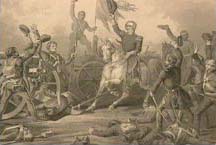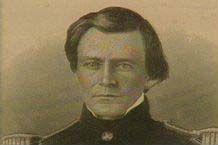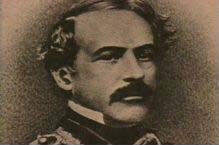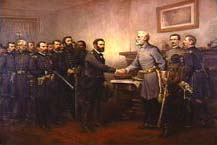The Aftermath of War
The Mexican-American War: Crucible for Greatness
by John C. Waugh
Author
 General Scott at Contreras by Chapin Smith
General Scott at Contreras by Chapin SmithSpecial Collections Division, The University of Texas at Arlington
The Mexican-American War stands for many things, admirable and not so admirable, in American history. But easily one of its most important and durable legacies was as the military laboratory and workshop, proving ground, crucible, and rite of passage for the men who would command on both sides in the American Civil War.
In the Mexican-American War, most of the young subalterns who would command at the highest levels in the larger war to come sat at the knee of two of the great generals of American history, Zachary Taylor and Winfield Scott. From them, in that relatively tidy war that knew no defeat on the American side, they learned what they knew of waging war on an epic scale.
The names of the commanders who learned war from these two mentor-generals in Mexico constitutes a virtual roll call of the American military pantheon of the 19th century — Robert E. Lee, U.S. Grant, Thomas "Stonewall" Jackson, George McClellan, P.G.T. Beauregard, James Longstreet, Albert Sidney Johnston, Joseph E. Johnston, George Thomas, George Meade, Edmund Kirby Smith, Braxton Brag, Joe Hooker, George Picket, and dozens of others.
And what did these commanders-to-be learn? What did they store in their memory banks from their Mexican experience that they later brought to bear in the war in which they were the commanders of armies? The opportunity to learn was there for them all. They saw the two great generals first hand and up close. They were witnesses to perhaps the most perfectly executed and efficient campaign in all of military history.
Their two mentor-generals couldn't have been more different in style. Taylor was a soldier's general. He often came up short on tactics and he lacked skill in the logistics of war, but when his men called him "Old Rough and Ready," they meant it out of respect. He was fearless and he shared every hardship in the field with his army. He was a general to have confidence in.
 Probably no commander in the Civil War patterned himself on Taylor as closely as Grant did. There was in Grant the same lack of great show or parade. Like Taylor, he was plain in dress and in pretensions. He, too, could face either danger or responsibility calmly, a trait Grant deeply admired. Others who served with Taylor in the opening battles of the war in northern Mexico also learned enduring lessons. Lee learned a healthy skepticism for frantic and overblown reports of enemy strength in his front, an acquired skepticism that would serve him well in the Civil War.
Probably no commander in the Civil War patterned himself on Taylor as closely as Grant did. There was in Grant the same lack of great show or parade. Like Taylor, he was plain in dress and in pretensions. He, too, could face either danger or responsibility calmly, a trait Grant deeply admired. Others who served with Taylor in the opening battles of the war in northern Mexico also learned enduring lessons. Lee learned a healthy skepticism for frantic and overblown reports of enemy strength in his front, an acquired skepticism that would serve him well in the Civil War.
But it was Scott, the thinking man's general, who emerged as the most influential mentor of the great Civil War commanders. Scott was perhaps the finest military mind of his century, or any century. In personality, he was the polar opposite of Taylor: conceited, devoted to pomp and circumstance, jealous of his prerogatives, often undiplomatic and abrasive. As Taylor was "Old Rough and Ready," Scott was "Old Fuss and Feathers." But he, too, was courageous, and he added to that trait a precise and original military intellect.
 Perhaps no Civil war general patterned himself so closely on Scott as did Robert E. Lee. Some of Lee's most salient military traits were nurtured under the brilliant Scott. Others learned the same lessons, but few would apply them with such striking success.
Perhaps no Civil war general patterned himself so closely on Scott as did Robert E. Lee. Some of Lee's most salient military traits were nurtured under the brilliant Scott. Others learned the same lessons, but few would apply them with such striking success.
What were these traits?
One of them was audacity. Everything in the Mexican-American War called for audacity. It was a war fought far from home, far from lines of supply, against a foe of overwhelming numbers. Scott's campaign, therefore, called for audacity from start to finish. Lee later carried that quality into battle after battle in the Civil War. And his lieutenant, Stonewall Jackson, displayed it in abundance in his classic Shenandoah Valley campaign and at Second Manassas and Chancellorsville. Grant never lacked it.
Another lesson Scott taught was the need to delegate responsibility. He believed a commanding general's job was to plan an operation, acquaint his commanders with the plan, see that his troops were brought to the seat of action at the right time and the right place — then leave the fighting of the battle in detail to his subordinate generals. A number of Civil War commanders borrowed that style from Scott, but none so notably as Lee.
Scott also knew the importance of trained staff, and leaned heavily on his young cadre of West Pointers. In the Civil War, Lee, Grant, and Jackson all put a high priority on building and maintaining smart, efficient staffs.
Reconnaissance was a Scott byword. He relied on it at every turn in Mexico. Lee and every other successful general in the Civil War gave it priority. All knew that victory required knowledge.
Scott was the master of the flank attack. His spectacular flanking movement at Cerro Gordo was a military classic for all time. Every future Civil War general on the scene who saw it, marveled at it. Nearly all of them looked to execute such a movement in the Civil War. Lee fashioned Cerro Gordos with stunning success at Second Manassas and Chancellorsville. In both cases, his instrument was that other devotee of the flank attack, Stonewall Jackson.
Another key lesson Scott taught ran counter to all accepted military practice. In the march from Veracruz to Mexico City, he boldly abandoned his lines of supply and communication. Lee copied this strategy later in both of his invasions of the North. Grant did it, Scott-style, at Vicksburg in 1863 and his protégé, William T. Sherman, took the tactic to its zenith in his march through Georgia and Carolinas late in the Civil War.
 Those who absorbed the lessons offered by the Mexican-American War and then later used them, went on to greatness in the Civil War. A handful of them — Lee, Grant, Jackson — stand today in the upper pantheon of great American generals. They stand there in large part because of what they learned in Mexico on the National Road to the Halls of the Montezumas.
Those who absorbed the lessons offered by the Mexican-American War and then later used them, went on to greatness in the Civil War. A handful of them — Lee, Grant, Jackson — stand today in the upper pantheon of great American generals. They stand there in large part because of what they learned in Mexico on the National Road to the Halls of the Montezumas.





